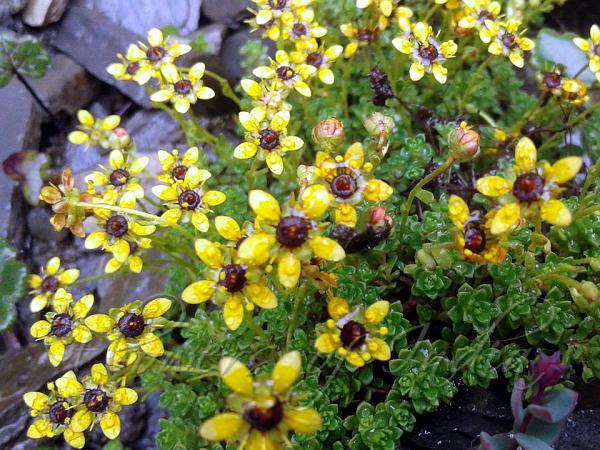|
| East-Himalayan Saxifrage |
|

|

|
|
|
|
Photo: |
Botanical name: Saxifraga engleriana Family: Saxifragaceae (Saxifrage family)
Synonyms: Saxifraga zangnanensis
Synonyms: Saxifraga zangnanensis
East-Himalayan Saxifrage is perennial herb, 1.5-3.5 cm
tall with branched shoots. It is named for Heinrich Gustav Adolph
Engler, 20th century German botanist. Flowering stem is brown crisped
hairy. Stem leaves are clustered into a rosette near middle of stem,
remote proximally and distally on stem, nearly spoon-shaped or narrowly
obovate to broadly elliptic, 2.2-5.2 x 1-2.2 mm, carnose, both surfaces
hairless on proximal leaves, margin proximally bristly-fringed with
hairs on distal leaves, tip blunt to subblunt. Yellow flowers are borne
singly on flower-stalks 4.1-7 mm, whitish crisped hairy. Sepals are
erect, then spreading, broadly ovate to nearly elliptic, below convex,
above concave, 1.9-2.6 x 1.2-1.7 mm, carnose, hairless, veins 3,
confluent at tip, tip blunt. Petals are yellow, elliptic to broadly so,
3-4.1 x 2-2.5 mm, 2-callose, 3- or 4-veined, base with a claw 0.4-1 mm,
tip blunt. Stamens are 2.5-4.2 mm. Ovary is semi-inferior, broadly
conical, 2.3-4 mm, with an annular nectary disc. Styles are 1.2-2 mm
long. East-Himalayan Saxifrage is found in alpine meadows, screes, rock
crevices in Eastern Himalayas, from Nepal to Bhutan, Sikkim, Arunachal
Pradesh, at altitudes of 4100-4700 m. Flowering: June-August.
| Identification credit: Nongthombam Ullysess | Photographed in Arunachal Pradesh. |
• Is this flower misidentified? If yes,